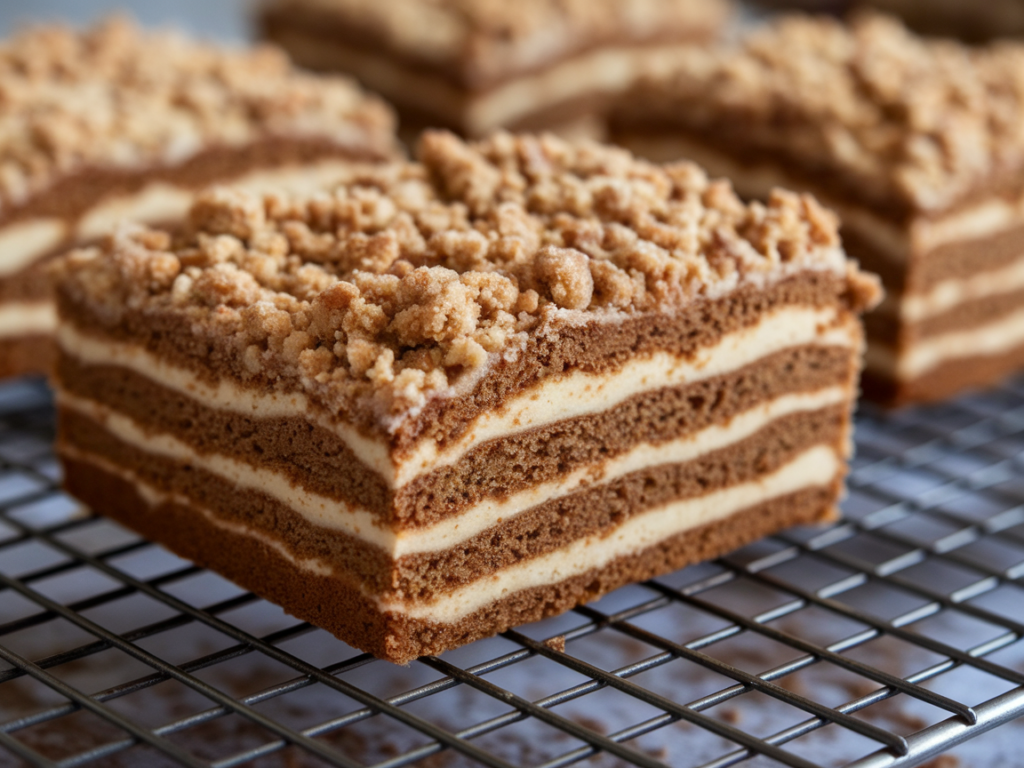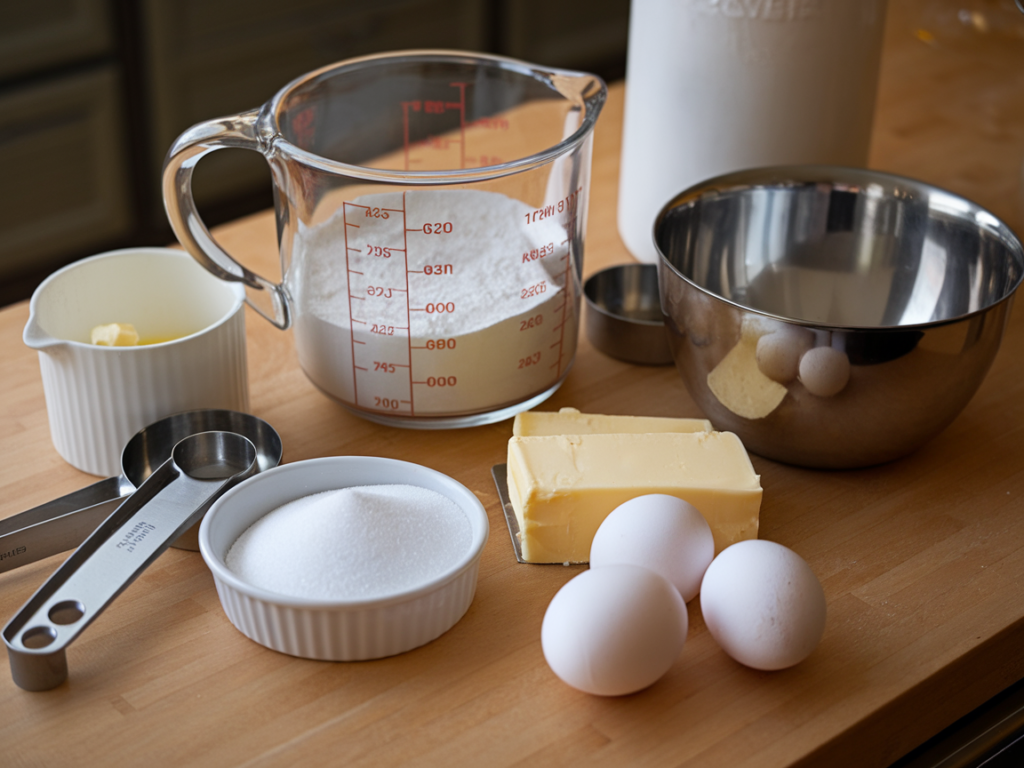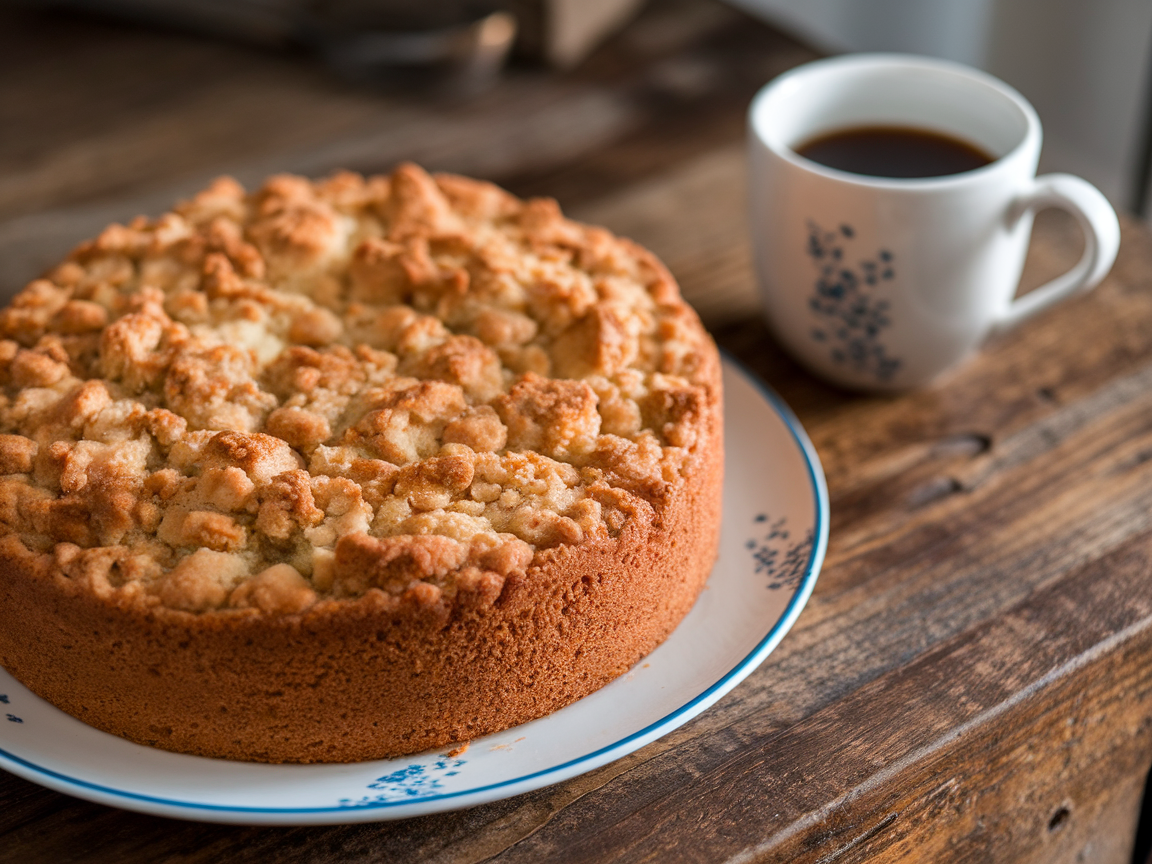Introduction to Coffee Cake Perfection
Ah, coffee cake! Just hearing the name makes you think of a cozy morning, a warm cup of coffee, and that delightful slice of soft, crumbly cake. But let’s be real—nothing ruins this comforting picture like a soggy coffee cake. It’s like biting into wet bread… yikes! So, how can we avoid this kitchen disaster? Don’t worry; you’re about to become a coffee cake expert.
In this guide, we’ll dive deep into what makes a coffee cake turn soggy, how to prevent it, and how to enjoy the best version of this classic treat every single time. Stick around, and you’ll never have to deal with soggy coffee cake again! 🎉
What Is Coffee Cake?
Before we tackle the sogginess problem, let’s set the stage. What exactly is coffee cake? Contrary to its name, coffee cake doesn’t always have coffee in it (though it pairs wonderfully with a cup of joe ☕). It’s usually a sweet, moist cake topped with a crunchy streusel made of sugar, butter, and flour, sometimes spiced up with cinnamon or nuts.
Coffee cake is supposed to be moist but not drenched. There’s a fine line between heavenly texture and a soggy mess, and crossing it can ruin the experience.
Why Does Coffee Cake Become Soggy?

Here’s the thing: soggy coffee cake doesn’t just happen randomly. There are specific reasons behind it. Let’s break them down:
Overmixing the Batter
Ever heard of “less is more”? That’s the golden rule when mixing cake batter. Overmixing activates the gluten in the flour, leading to a dense and gummy texture that traps too much moisture. Think of it like chewing gum—it’s sticky and holds onto everything.
Incorrect Baking Temperature
Baking at the wrong temperature is a rookie mistake. If your oven is too hot, the cake’s exterior might bake too quickly, leaving the inside undercooked and soggy. Too low, and the cake might never bake through properly. It’s all about balance.
Insufficient Cooling Before Storage
Patience is key. If you store your coffee cake while it’s still warm, steam gets trapped, creating a moisture bomb. This is a common culprit behind soggy cakes!
High Moisture Content Ingredients
Certain ingredients, like fruits or even too much butter, can increase the cake’s moisture levels. While they add flavor, they can also tip the balance toward sogginess if not handled correctly.
Preventing Sogginess During the Baking Process

Now that we know why it happens, let’s figure out how to stop it. The baking process itself plays a massive role in the final texture of your coffee cake.
Measuring Ingredients Accurately
First things first—get yourself a good kitchen scale. 🧑🍳 Why? Because baking is a science, and a pinch too much of one ingredient can throw everything off. For example, too much liquid or too little flour can make your cake soggy.
Here’s a quick cheat sheet for common measurements:
| Ingredient | Quantity |
|---|---|
| All-purpose flour | 2 cups (240g) |
| Sugar | 1 cup (200g) |
| Butter | ½ cup (115g) |
| Milk | 1 cup (240ml) |
Use precise measurements to keep the moisture levels just right!
Choosing the Right Pan for Even Baking
Think the pan doesn’t matter? Think again! A pan that’s too small can cause the cake to rise unevenly, leading to dense and soggy spots. A good rule of thumb is to stick to the size mentioned in the recipe—usually an 8×8 or 9×9 inch square pan.
Mastering the Perfect Baking Temperature
Set your oven to the temperature stated in the recipe (typically 350°F or 175°C). But don’t just trust the oven’s built-in thermometer; they’re not always accurate. Use an external oven thermometer for precise baking.
👉 Pro Tip: Preheat your oven for at least 15 minutes to ensure consistent heat distribution.
Cooling the Cake Properly
Once your cake is out of the oven, don’t let impatience ruin your hard work. Proper cooling is critical:
- Step 1: Let the cake sit in the pan for about 10 minutes. This allows it to settle without becoming soggy.
- Step 2: Transfer the cake to a wire rack to cool completely. Air circulation underneath the cake helps prevent moisture buildup.
- Step 3: Avoid covering the cake until it’s completely cooled to prevent trapped steam.
Block Quote:
“Patience isn’t just a virtue in life—it’s the secret to a perfect coffee cake!”
Solutions for Storing Coffee Cake Without Sogginess
So, your coffee cake has turned out amazing—hooray! But wait, how do you store it without it becoming a soggy mess? Let’s get into some tried-and-true methods to maintain that fresh, crumbly texture.
Cooling the Cake Properly
We’ve touched on this, but it’s worth repeating: cooling is crucial. Any residual warmth will cause condensation, and condensation is the enemy of crisp coffee cake. Here’s a checklist:
- Let it cool in the pan for 10 minutes. This lets it stabilize without creating steam.
- Transfer to a wire rack for full cooling. Make sure it’s completely cool before storing—no shortcuts!
Wrapping Techniques to Retain Freshness Without Trapping Moisture
When it comes to wrapping your coffee cake, not all methods are created equal. A tight seal is important, but you don’t want to trap moisture. Here’s how to do it right:
- Plastic Wrap & Parchment Combo: Wrap the cake in parchment paper first, then seal it with plastic wrap. This prevents direct contact with the plastic while still locking in just the right amount of moisture.
- Aluminum Foil: This is a great alternative if you don’t have plastic wrap handy. It’s less breathable but works well for short-term storage.
Best Storage Containers for Coffee Cake
Choosing the right container can make a big difference in preserving texture. Airtight containers work best for short-term storage, but don’t cram the cake inside. Leave a little room to avoid smashing that lovely crumb topping.
👉 Pro Tip: If your kitchen is humid, consider adding a small piece of paper towel inside the container to absorb excess moisture.
Enhancing Coffee Cake Texture and Flavor
Once you’ve mastered the basics, why not take your coffee cake to the next level? With a few tweaks, you can achieve the perfect balance of texture and flavor without the risk of sogginess.
Adding Crunchy Toppings Without Overloading Moisture
A streusel topping is the crown jewel of any coffee cake. But if it’s too heavy or moist, it can sink into the cake and ruin the balance. To get it just right:
- Use cold butter when making the topping. It creates that perfect crumbly texture.
- Sprinkle the topping evenly over the batter to prevent soggy pockets.
Using Alternative Ingredients for a Moist but Not Soggy Cake
Want a cake that’s moist but not wet? Here are some ingredient swaps to consider:
- Replace some of the oil or butter with Greek yogurt. It adds moisture without making the cake overly dense.
- Use applesauce for a natural sweetness that won’t overwhelm the texture.
- Opt for buttermilk instead of regular milk—it’s thicker and adds a slight tang for flavor depth.
Nutrition Facts (Per Slice)
| Component | Amount |
|---|---|
| Calories | 250 |
| Total Fat | 12g |
| Saturated Fat | 7g |
| Carbohydrates | 30g |
| Protein | 4g |
Common Problems and Troubleshooting
Even the best bakers run into issues sometimes. Here’s how to troubleshoot if your coffee cake doesn’t turn out as expected.
What to Do If Your Coffee Cake Is Already Soggy
It happens! If you realize your cake is too wet, don’t panic—there are ways to salvage it.
- Reheat in the Oven: Place the cake in a preheated oven at 300°F (150°C) for 10-15 minutes. This can help dry out excess moisture without overbaking.
- Slice and Toast: Cut the cake into individual slices and toast them lightly in the oven or toaster. It creates a delicious crispness that can mask any sogginess.
Fixing Soggy Coffee Cake in the Oven
If the center of your cake is still underbaked after removing it from the oven, you can fix it:
- Cover the top with aluminum foil to prevent the crust from burning.
- Return it to the oven at a slightly lower temperature (325°F or 165°C) and bake until the center is fully cooked.
Block Quote:
“Remember, even a soggy coffee cake can be a delicious learning experience!”
Expert Tips from Bakers for Perfect Coffee Cake
Want to know the secrets that professional bakers swear by? These expert tips will help you avoid sogginess and bake a coffee cake that’s the talk of the table.
Balancing Moisture and Texture
When it comes to coffee cake, balance is everything. Too much moisture can lead to sogginess, while too little results in a dry, crumbly disaster.
- Use Room-Temperature Ingredients: Room-temperature butter, eggs, and milk blend better, ensuring an even texture.
- Don’t Overdo the Liquids: Follow the recipe to a T when adding milk or other liquids. If the batter looks too thin, don’t hesitate to add a tablespoon of flour at a time to balance it out.
Seasonal Ingredients and Their Impact on Coffee Cake
Ever noticed how fruits like berries or apples can vary in moisture depending on the season? This can seriously affect your coffee cake. Here’s how to adapt:
- For Juicy Summer Fruits: Toss them in a little flour before folding into the batter. This helps absorb excess moisture.
- For Drier Winter Fruits: Soak them in a bit of water or juice before adding them to the mix.
To ensure your coffee cake remains moist yet perfectly textured, consider exploring recipes like the Oatmeal Streusel Coffee Cake – Easy & Delicious Recipe, which balances moisture and texture effortlessly. For those interested in gluten-free options, the guide on Are Banana Bread Muffins Gluten-Free? A Complete Guide provides valuable tips on avoiding sogginess in alternative baked goods. If you’re looking to get creative with ingredient swaps, the article What Can You Substitute Cream Cheese for in Buffalo Chicken Dip? offers practical ideas that can inspire unique twists for your coffee cake. These resources will help you master baking techniques and enhance your coffee cake experience!
Conclusion: Enjoying Coffee Cake with Confidence
Baking the perfect coffee cake doesn’t have to be a guessing game. By understanding the causes of sogginess and mastering simple techniques, you can create a cake that’s moist, flavorful, and absolutely delicious every single time.
Recap of Key Steps to Avoid Sogginess
- Measure your ingredients accurately.
- Use the right pan size and bake at the proper temperature.
- Let the cake cool completely before storing.
- Wrap and store it correctly to maintain texture.
Encouragement to Experiment and Perfect Your Recipe
Now that you’ve got the tools and tips, why not have a little fun? Experiment with toppings, fillings, or even spices. Who knows—you might just create the ultimate coffee cake recipe!
Block Quote:
“Baking is as much about creativity as it is about precision. Don’t be afraid to make it your own!”
So, the next time someone asks, “How do you keep coffee cake from getting soggy?” you’ll have all the answers—and the perfect slice of coffee cake to prove it. 🍰☕

